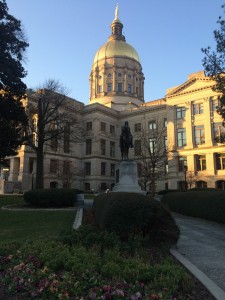Davis, Janel, Scott J. Trubey, and Katie Leslie. “Turner Field Holds Future for Georgia State, Neighborhoods.” Atlanta Journal Constitution Saturday Dec. 2015: n. pag. MyAJC. Web. Friday Feb. 5.
Davis, Trubey’s and Leslie’s article in the Atlanta Journal Constitution details the plans for the land currently occupied by the Atlanta Braves’ home stadium, Turner Field. The Braves’s final season at Turner Field will be in 2017. The upcoming departure of the pro baseball team prompted bidding by several groups only to be won by Georgia State University. The AJC writes that Georgia State has already revealed plans for the newly acquired land. Along with the development of the surrounding communities, the land will be used for a new football stadium for the Georgia State Panthers. Georgia State is currently fundraising to help fund the 300 million-dollar project. The authors did a good job of reporting from an objective point of view and staying true to the facts the people of the community need to know. I chose this article to better my understanding of real estate pertaining to the built environment.
Ornstein, Norm. “Why Bernie Sanders Can’t Govern.” Atlantic 2 Feb. 2016: n. pag. The Atlantic. Web. 5 Feb. 2016.
“Why Bernie Sanders Can’t Govern,” by Norm Ornstein is a magazine article explaining why many Hillary Clinton supporters feel that Clinton is the better candidate for several reasons that usually go unmentioned. Ornstein details that Bernie Sanders, like Ted Cruz is too extreme and has unrealistic views of the political climate of today’s America. Not only does Ornstein feel that Sanders is misguided but also at a disadvantage. According to the author, for Sanders to win he would have to channel an Obama-esque campaign to get the demographic he appeals to most to actually go out and vote. Next, if elected president, Sanders would be limited in the legislation he would be able to establish due to the stiff Republican congress he would face. This article is clearly biased and meant to sway voters to see the election from a different perspective. The author was effective in helping readers see the presidential race from a point of view they most likely haven’t seen it from.
Cook, Rebecca. “Michigan Emails Show Officials Knew of Flint Water Disease Risk.” Reuters. N.p., 4 Feb. 2016. Web. 5 Feb. 2016.
This piece written by Rebecca Cook tells of what some what call a scandal in the Flint, Michigan government. Recent emails have surfaced that prove that high-ranking officials in the Michigan state government were aware of the rise in Legionnaires’ disease and its relation to the issues with the water in Flint. As expected, a spokesman for the governor denied the reports and claimed that Rick Snyder did not have any knowledge of the outbreak until January of this year, days before an official announcement of crisis was made. The author comes off as credible due to the several different sources utilized to compose the report. Quotes from both sides of the story are used to round out the article smoothly and fairly. The only weakness of this writing is the short length of it. An article with such subject matter should be more detailed.



